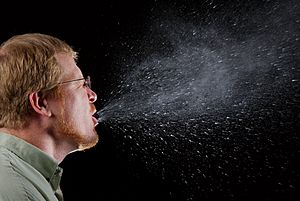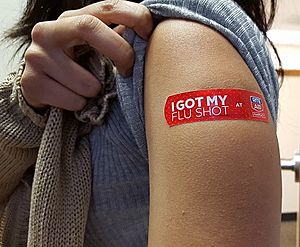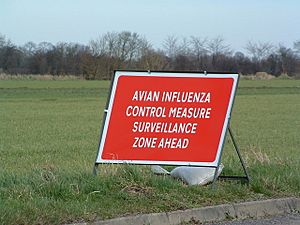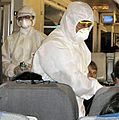Influenza facts for kids
Influenza, often called the flu, is a common sickness that affects people, especially children. It's not just for humans; many animals like mammals and birds can also get the flu. Different viruses cause the flu, which is why you can catch it more than once. The word influenza comes from an Italian word meaning "influence."
Contents
How Flu Spreads and What It Feels Like
The flu spreads very easily from person to person. It usually travels through tiny drops of mucus and fluid that get into the air when someone who is sick coughs or sneezes.
Common flu symptoms include:
- Cough
- Sore throat
- Muscle aches and pains
- Fever
- Headache
- Sometimes, vomiting and diarrhea
The flu can also lead to other serious illnesses, like pneumonia. This makes it especially risky for young children and older people.
There isn't a cure for the flu, but special medicines called antiviral drugs can help. They can make the illness less severe and not last as long.
The flu season usually runs from late fall to spring. Most people catch it during the colder winter months. When many more people than expected get the flu in one area, it's called an epidemic. If a lot of people around the world get the same type of flu, it's called a pandemic.
Three main types of flu viruses affect people: Type A, Type B, and Type C. The virus usually spreads through the air when people cough or sneeze, especially when they are close to each other. You can also get the flu by touching surfaces with the virus on them, then touching your mouth or eyes. A person can spread the flu even before they show symptoms and while they are sick. Doctors can test your throat or nose to confirm if you have the flu.
Stopping the Flu from Spreading
Washing your hands often helps a lot to stop the flu from spreading. Wearing a surgical mask can also be helpful. Health experts like the World Health Organization suggest getting a flu shot every year, especially if you are at high risk. The flu shot usually protects against three or four types of flu. It's generally safe and doesn't cause many problems. A flu shot from one year might not work the next year because the virus changes quickly.
How Flu Viruses Change
Flu viruses often change a little bit as they pass from person to person. This is the main reason why you can get the flu every year.
The CDC keeps track of the different flu viruses going around. They share this information with companies that make flu shots. Since the flu changes so much each year, you need a new flu shot for each new flu season.
Flu shots only protect against the most common flu viruses. Sometimes, a slightly different type of flu spreads more than expected. Even then, the flu shot often gives some protection. This means if you get the shot and still catch the flu, you might not get as sick.
Some flu viruses come from animals. For example, Bird flu usually only affects people who are in close contact with sick birds, like chickens. These types of flu are usually very limited. While they can make a person very sick, they usually don't spread easily from one person to another.
Another way the flu can change is when a person or animal catches two different flu viruses at the same time. The two viruses can swap some of their genetic information. This can create a brand new flu virus that no one has ever caught before.
If an animal flu virus changes and can easily spread from human to human, many people can get sick. This is because no one has any natural protection against the new virus. Often, a brand new virus can be more serious and cause more deaths.
New types of flu viruses usually cause pandemics. This is why many scientists have been watching Bird Flu closely. It can be very dangerous if it changes enough to spread easily between people.
The flu spreads around the world in yearly outbreaks. These outbreaks cause about three to five million serious illnesses and around 250,000 to 500,000 deaths each year. In the northern and southern parts of the world, outbreaks happen mostly in winter. Near the equator, outbreaks can happen any time of the year.
About three times every century, a pandemic happens. These infect a large part of the world's population and can kill millions of people. For example, the 1918 flu pandemic was very severe. If a similar flu happened today, it could kill between 50 and 80 million people.
Deaths from flu happen mostly in young children, older people, and those with other health problems. Larger outbreaks called pandemics are less common. In the 1900s, there were three major flu pandemics:
- The Spanish flu in 1918 (about 50 million deaths)
- The Asian influenza in 1957 (two million deaths)
- The Hong Kong influenza in 1968 (one million deaths)
In June 2009, the World Health Organization announced a new type of flu, influenza A/H1N1, was a pandemic. Flu can also affect other animals like pigs, horses, and birds.
Controlling Flu Infections
There are good ways to help stop the flu from spreading. These include good personal habits like:
- Not touching your eyes, nose, or mouth.
- Washing your hands often with soap and water, or using hand sanitizer.
- Covering your mouth and nose when you cough or sneeze.
- Staying away from sick people.
- Staying home yourself if you are sick.
Since the flu spreads through tiny airborne particles and by touching dirty surfaces, cleaning surfaces can help. Alcohol is good at killing flu viruses. Special cleaning products can also be used with alcohol to make the cleaning effect last longer. In hospitals, strong cleaners are used to clean rooms where flu patients have been. At home, you can use a diluted bleach solution to clean surfaces effectively.
During past pandemics, things like closing schools, churches, and theaters were used to slow the virus. These actions helped slow the spread but didn't greatly change the total number of deaths. It's not clear if reducing public gatherings, like closing schools, will always reduce the spread. This is because sick people might just move to other areas. Such rules can also be hard to make people follow and might not be popular. When only a few people are sick, keeping them separate can help lower the risk of spread.
Treating the Flu
If you have the flu, it's important to get lots of rest and drink plenty of liquids. You should also avoid alcohol and tobacco. If needed, you can take medicines like acetaminophen (paracetamol) to help with fever and muscle aches.
Important safety note: Children and teenagers with flu symptoms, especially fever, should not take aspirin. Taking aspirin during a flu infection, especially with influenza type B, can lead to a rare but very serious liver disease called Reye's syndrome.
Since a virus causes the flu, antibiotics won't help. Antibiotics only work against bacteria. They are only used if you get another infection, like bacterial pneumonia, because of the flu. Antiviral medicines can be helpful if taken early. However, some types of flu can become resistant to these standard antiviral drugs.
Swine Flu (2009)
This flu virus got its name because it had parts of its genetic code that are often found in flu viruses that infect pigs. But it's important to know that this was a new human virus that spread from person to person. It was not spread by pigs or by eating pork.
Even though new information about swine flu was always coming out, it didn't seem as severe as bird flu or the flu that caused the terrible 1918 Spanish flu. However, it was too early to know if it would cause the next big flu pandemic.
Images for kids
-
Thermal imaging camera and screen, photographed in an airport terminal in Greece during the 2009 flu pandemic. Thermal imaging can detect elevated body temperature, one of the signs of swine flu.
-
Professional examining a laboratory-grown reconstruction of the 1918 Spanish flu virus in a biosafety level 3 environment
See also
 In Spanish: Gripe para niños
In Spanish: Gripe para niños













